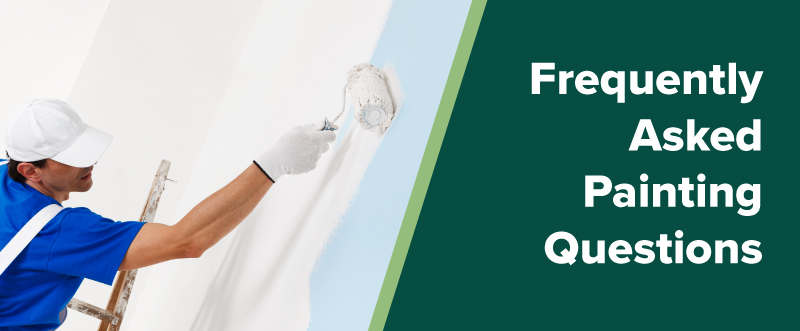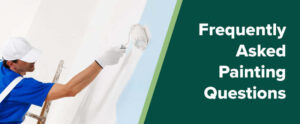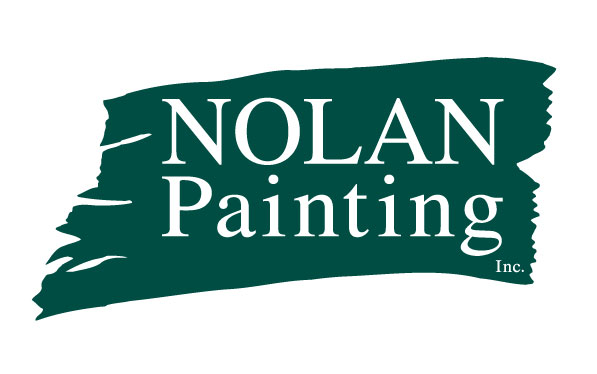Frequently Asked Painting Questions

Frequently Asked Painting Questions And Answers
If you’re looking for a painting company, you will soon become to understand the benefits of hiring professional painters. Our team can walk you through the entire process, answering all of the questions you may have along the way. Take a look below at some of the most frequently asked painting questions and answers as you begin to navigate your painting project.
General Questions to Ask When Hiring a Painter
Since you’ve decided to hire a painter for your house, there are common house painting questions you will likely want to ask before you decide they’re the company you want to hire.
- What type of paint do you use and why?
We primarily use quality products from Sherwin Williams and Benjamin Moore. If there’s another brand you’re interested in using, talk with your estimator, we’d be happy to accommodate you.
- Do you still use oil-based paints? What is the primary difference between oil- and water-based (acrylic, latex) paints? What are the benefits of each?
Oil-based paints have mostly been removed from the market since they are not as environmentally friendly as newer options such as latex paint (water-based) and acrylic (chemical-based). Oil-based paints can have hydrocarbons and high levels of volatile organic compounds (VOCs). While they do have some redeeming qualities, (smoother look, good moisture resistance, ultimate hardness, and durability), they tend to become very brittle as they age. This can lead to cracking, peeling, and ultimately to the failure of the paint. Also, when used on exteriors and moisture-prone areas on interiors, oil-based paints have a tendency to mildew because some of their ingredients act as a food source for mildew.
On the other hand, latex and acrylic paints have come a long way and now outperform their oil-based counterparts. Today’s latex and acrylic paints exhibit excellent qualities such as moisture resistance, mildew resistance, flexibility, colorfastness, and block resistance (the ability to not stick to itself or other objects, such as items on a painted shelf). Most of the water-based paints we use are known as 100% acrylic, which is of the highest available quality.
- What types of environmentally friendly options do you offer?
Most paints already have low VOCs. However, non-VOC paints are available upon request.
- How many coats of paint are included in the quote?
We always apply two coats of paint, guaranteed. However, there are some cases where two coats are not needed. If this is the case, we would discuss it with the customer.
- If I buy all of my own materials, will I be able to save money that way?
When you work through professional companies such as Nolan Painting, we advise that you allow the professionals to provide the materials as they generally get discounts due to the number of materials they purchase for their business. Our estimates include the cost of paint!
- What is the typical longevity of a new paint job?
When done well, most paint jobs should last between seven and ten years. There are several factors that affect the longevity of a paint job including the exterior’s finish, where you are located, and the quality of the previous paint job.
It’s also important to consider how well the area being painted is prepared. Prepping an area for paint is a key factor in how long the paint job will last. Also, the quality of the surface being painted is a factor. When painting an outdoor surface, how much that surface is exposed to the elements and whether or not the building being painted is protected by other buildings can play a role in how long that paint job will last.
Interior Painting Questions
- How does lead paint impact a painting project?
There has been no lead paint used for residential purposes since 1978, when it was deemed against the law. But even if your home has been painted since 1978, it’s highly likely that lead paint is present. Therefore, we are required to test for lead paint in any home built prior to 1978. Our painters undergo lead-safe training and adhere to the correct practices.
If the tests for lead return positive, we must and will take all precautions to ensure that your family, our employees, and the environment are safe and protected.
- If a paint says it’s a paint and primer all-in-one, does that mean primer is mixed in with the paint?
These types of paints don’t actually have primer mixed in with them, but they do have a resin that gives them the property of good adhesion. This will make the use of primer unnecessary in many circumstances.
- Would you need to prime an area before painting it with another coat of latex paint?
No, we don’t always need a primer when we repaint with another coat of paint. We would lightly sand the area you wish to repaint and clean that area thoroughly. Once this is done, we repaint the area — though you may need more than one coat of paint. If you’re changing sheens of paint or making a significant change in colors, we may need to use a primer.
- What are the different kinds of paint finishes?
- Flat (Matte) Finish — Little to no shine at all. This finish is great for covering imperfections on the surface but is not the most durable option.
- Eggshell Finish – This low-luster finish provides a small amount of shine. Eggshell finishes are great in areas that do not get very dirty, (i.e. low traffic areas such as an entryway or living room.)
- Satin Finish – This is the most popular finish for interior spaces in a home. This finish has a velvety sheen. It’s easy to clean so it can be used in high traffic rooms like your kitchen!
- Semi-Gloss – This finish has more shine and reflective qualities than other finishes. It’s great for rooms that get a lot of traffic and steam such as bathrooms as it’s mildew-resistant.
- High-Gloss – This finish is the shiniest, most durable, and easiest to clean. This type of paint is perfect for cabinetry, doors, and certain trims.
- What are the advantages of using flat finish paint?
This type of paint will reflect a greater amount of light, and the surfaces will look more uniform. Imperfections are minimized and the surface area to be painted does not require as much preparation, meaning little sanding is required, unlike paints with a higher gloss or sheen.
Flat finish paints are less likely to show marks where the painting has been done, which are called “lap marks.” The lap marks will occur when you paint one section which dries before the other section has been painted.
- Why would you want to avoid using flat paint?
These paints are not very stain-resistant, and should not be used if you have a surface you will need to clean or scrub frequently. They are also not very resistant to moisture and shouldn’t be used in areas that have high humidity, such as bathrooms.
- Why would I want to use a higher gloss or sheen paint?
This type of paint resists stains and dirt better, so the surface will stay clean for a longer period of time. Surfaces painted with higher-gloss paints are also easier to clean and more resistant to humidity. Therefore, these paints are best suited for high-traffic areas and bathrooms.
- Why avoid using higher-gloss paint?
These types of paints will show imperfections in the surface much more than flatter paint. Additionally, it’s more difficult to do touch-ups with higher-gloss paints, as any touch-ups will likely show.
- Can you offer advice on how to choose a color?
Lighting, architecture, and room décor are three factors to consider when choosing a paint color. An ideal paint color is one that considers all three elements and provides balance and unity to the space. At Nolan Painting, we offer a free consultation with our color consultant with any booked job.
- What if I don’t like the color selected? Can I change it?
Yes. The final color is ultimately the homeowner’s choice, but note that there will be an additional cost for a color change. The additional cost is determined by how much of the job was already completed, along with the cost of the additional paint.
- How can I ensure that my interior paint job will last as long as possible?
Interior painting jobs can get dirty quickly, especially around light switches and doorknobs, it’s important to wipe away any spots that accumulate before they become trapped in the paint. Dirt spots are most likely to occur in areas near where you’re cooking. Cooking oil, once airborne, can land on the nearby walls.
To remove spots on your paint, we recommend that you first try removing any spots with a soft cloth and mild soap to avoid damaging the sheen of the paint before you resort to harsher cleansers. Once you have cleaned the spot, remove any residue left from the soap so it will be easier to apply paint, should you decide to paint the wall again in the future.
Exterior Painting Questions
- Can you paint the exterior of my home in the wintertime?
The exterior of your home cannot be painted in the winter. The winter season in the Philadelphia area lasts from the beginning of December to mid-April.
- Are there certain times of year or weather conditions that would prohibit any type of service?
Yes, we cannot in temperatures below 35 degrees Fahrenheit.
- How can I increase the length of time my paint job will last?
You will need to make sure you secure the highest-quality paints and materials. Also, you will want to have your home power-washed every few years to extend the life of an external paint job.
Pro tip: Stucco and aluminum siding should be repainted every 5-6 years. Wood siding should be repainted every 3-7 years, or stained every 4 years.
Questions About Painting a Business
- How will I know when I should paint the outside of my business?
Obvious signs that you need a new paint job include paint cracking, peeling, blistering, or mold on the painted surface.
- What procedures do you use to make sure the paint will bond with the surface?
Preparation is key! All surfaces are different and have different abilities to bond to paint. In order to ensure good bonding, you want to make sure the surface you are painting is clean!
- What paint brands do you recommend for use on the exterior of a commercial building?
Painters should use the top premium brands of paint that will provide a thick covering that’s durable and will be able to hold up to the weather in your climate.
Why Choose Nolan Painting?
As longtime members of the residential and commercial painting industry, we understand that your property is one of your largest investments. That’s why we are committed to doing the job right the first time and in accordance with your vision. Here are a few questions to help you get to know us better.
- How long will the job take?
Each job can be different depending on the project. When you give us a call to explain what you are looking to have done, we can discuss the scope of work and give you an estimated timeline. We do guarantee the job will get done within 10 days or less if you’re having a job done in the winter season. A typical bedroom would take about a day or two to paint the walls, including ceiling and trim. You should plan on not having access to the bedroom for at least one night.
- How quickly can an estimator get to my home?
The wait time for an estimate is generally one week or less. There are times during the year (April, May, and June) when we get many calls, and during which the wait time can reach two weeks.
- What are the benefits of working with you?
Our success is based on delivering high-quality painting services with exceptional customer service. We stand behind our work and will make sure you’re happy with the experience and the finished product.
- How do I prepare my rooms for your visit?
You will need to remove any small items from the tops of shelves and pictures from your walls. We can move the larger items toward the center of the room to properly cover and protect furniture/items.
- How much will this painting job disrupt my home?
Disruption is kept to a minimum. At the end of each day, our crews will clean the areas we’re working in and move tools and paint to a shop area (garage or basement).
- My room is wallpapered now. How will you handle that?
We will remove the wallpaper prior to painting. Before we remove the paper, we will test an area to see how the paper was applied. If the wallpaper was not applied properly, it may lead to damage to the walls when the paper is removed. Your crew leader will discuss your other options if this is the case.
- Can you fix water damage or holes in my walls, and if so, how long will it take?
We will fill old holes, fix water damage and make any other repairs as needed, as part of our preparation. The time it takes to repair is in proportion to the amount of damage.
- Can I trust your employees?
Yes. Our professional custom painters are full-time employees and not subcontractors. We perform reference and background checks for everybody we bring on board.
- Are you insured?
Yes. For your protection and ours, we offer up to $2 million liability.
- Are you licensed?
We have all appropriate licenses, which include PA Home Improvement Contractor #020814 and EPA Lead Safe Certified Firm NAT-26976-1. Each Crew Leader is EPA Certified. All employees receive Lead Safe Training.
- Do you offer a warranty?
Yes! We offer a two-year limited warranty.
- Can you provide references?
Yes, we can! We can give you a recent customer to call or have you look at our report cards that customers fill out at the end of each job. We also have excellent five-star online reviews posted on our website and on Angie’s List, Google+, and Houzz.
Contact Nolan Painting Today!
Do you still have a question? We’d love to hear from you! One of our experienced staff members will provide you with an answer that always emulates the Nolan Promise. Feel free to contact us for your residential painting services today!


